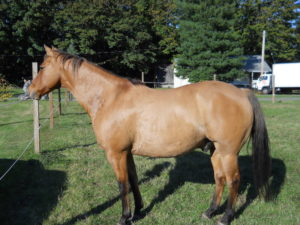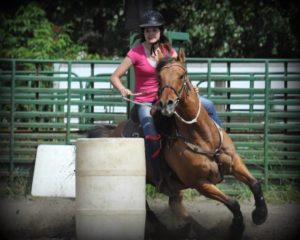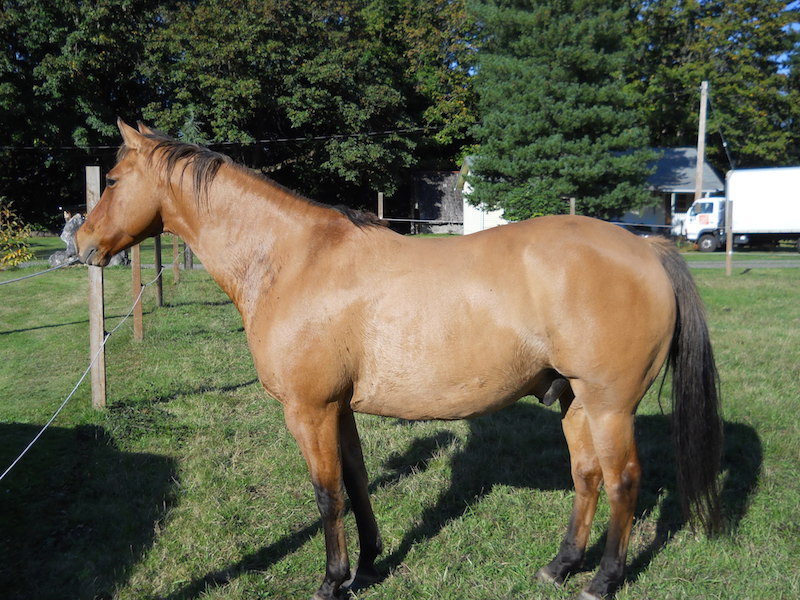How to Get Your Horse Shiny, Slick and In Shape
by Gina Fresquez, MS, CHHC
Now that the weather is getting warmer and we are starting to ride a lot more, you might be wondering about the best way to get your horse back into tip-top shape for the show season. Maybe your horse has taken the last few wet winter months off and now it is time to get back into shape, or maybe you are preparing for a heavy competition season ahead. As you think about the best way to approach this there are some things to consider when deciding what will work best for your horse as an individual.
Begin with an overall evaluation of your horse and his condition. This would include looking at your horse’s skin, hair coat, muscling, weight and body condition score to determine what needs to be improved, by how much and what you want from your horse this season.
If your horse needs improved skin and hair coat, nutritionally there are some suggestions to be made in the diet. Staring with an already balanced diet containing essential vitamins, minerals and protein, increasing the amount of quality fats he consumes can have a big influence on creating conditioned skin as well as a slick and shiny hair coat. A quality fat would include any ingredient, supplement or feed containing a higher level of fat from flax seed, rice bran and/or vegetable oils. The general recommendations for adding fat to the diet will depend on your specific horse and which fat you choose, but should be anywhere from 4 to 6 ounces per day.


To evaluate your horse’s muscling, you should examine his major muscle groups like the chest, shoulder, forearm, stifle, gaskin, topline, croup and buttocks. Do you need any more development and strength in those areas? Pay particular attention to the topline, one of the hardest places to develop muscle. Run your hand along the topline of your horse to the point above the hips. Your goal is to get that area as flat as possible, without any ridge or sloping sides. To achieve this you must begin to slowly get your horse on an exercise regimen (please consult your trainer or veterinarian) AND also provide quality amino acids in the diet to build strong adequate muscle tone. Amino acids are the building blocks of protein and therefore are necessary in the diet to move forward with improved muscle development. These types of amino acids (like lysine and methionine) are not completely present in most forages so feeding a quality supplement or horse feed ration that contains adequate protein will be needed. If you continue to increase the workload of the horse without increasing quality protein in the diet, your horse will actually begin to lose muscle tone over time.
Does your horse need to gain or lose weight? This can be determined not only by weighing your horse with a scale or weight tape, but also by evaluating your horse’s body condition. This can be determined by using the Henneke horse body condition scoring system, which was developed by Texas A&M University, and is a universal standardized way of evaluating a horse’s bodyweight. This system uses palpation and sight to determine a score from 1 to 9, deciding whether a horse is underweight, just right, overweight or obese (more information on the Henneke system can be found online). If you determine your horse needs to gain weight, then feeding for additional calories is necessary. Keep in mind a half pound of gain for the horse requires 3,000 calories over maintenance. This can be achieved by increasing the current ration by roughly 2 to 3 pounds or by feeding a higher calorie feed or supplement to your horse. If you determine your horse needs to lose weight, cutting back where you can on excess calories coming from too much forage and/or grain and fat supplements along with increased exercise is necessary. Keep in mind that when cutting back on forage, your horse needs at least 1% of his body weight in roughage to maintain a healthy digestive tract.
With an accurate and thorough evaluation and a few feed adjustments, this should be a great starting point for getting your horse prepared and in shape for the show season ahead—shiny, slick and in shape!
Published May 2014 Issue
Gina Fresquez, MS, is a lifelong horse enthusiast with a passion for helping horse owners make sense of equine nutrition. She received her BS in equine science and Master’s degree in equine nutrition from the University of Arizona and has worked as a technical equine specialist for Purina Animal Nutrition since 2006. Gina works closely with horse owners, stables and veterinarians determining feed rations, testing hay, and addressing nutritional related challenges in the Pacific Northwest.
Contact Gina and find out more information: www.horse.purinamills.com.
Cell: (206) 743-6453
Email: [email protected]






